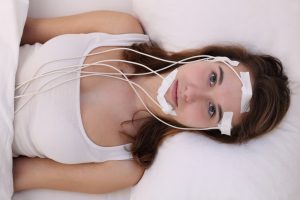It is believed that light in the evening is bad for sleep. But does the color of the light also play a role? Researchers from the University of Basel and the Technical University of Munich (TUM) compared the influence of different colors of light on the human body. The experts’ results contradict the results of an earlier study on mice.
Vision is a complex process. The visual perception of the environment is created by a combination of different wavelengths of light, which are decoded in the brain as colors and brightness. Photoreceptors in the retina first convert the light into electrical impulses: When there is enough light, the cones enable sharp, detailed and colorful vision. Rods only contribute to vision in low light conditions, so different shades of gray can be distinguished, but vision is significantly less accurate. The electrical nerve impulses are ultimately transmitted to ganglion cells in the retina, and then via the optic nerve to the visual cortex in the brain. This brain region processes neuronal activity into a colorful image.
Does the Color of Light Influence the Circadian Rhythm?

The question arises as to whether the cones and therefore the color of the light also have an influence on the internal clock. Finally, according to Dr. Christine Blume, who researches the effect of light on humans at the Center for Chronobiology at the University of Basel, on the most striking changes in brightness and light color at sunrise and sunset, which mark the beginning and end of a day. The research team from the University of Basel and TUM has published their results in the journal “Nature Human Behavior”.
It is Not the Color of Light, But Rather the Ganglion Cell that Plays an Important Role
The experts note that a 2019 study on mice suggests that yellowish light has a stronger influence on the internal clock than bluish light. In humans, the main effect of light on the internal clock and sleep is probably mediated via light-sensitive ganglion cells. However, there is reason to believe that the color of light encoded by the cones may also be relevant to the internal clock.
To get to the bottom of this, the researchers exposed 16 healthy volunteers to a bluish or yellowish light stimulus for an hour in the late evening and, as a control condition, to a white light stimulus. The light stimuli were designed to activate the color-sensitive cones in the retina differently and in a very controlled manner. However, stimulation of light-sensitive ganglion cells was the same in all three conditions. Differences in the lighting effect were directly due to the respective stimulation of the cones and ultimately to the color of the light. This method of light stimulation makes it possible to separate in a clean experimental way the properties of light that may play a role in the effect of light on humans.

The researchers found no evidence that variation in light color along a blue-yellow dimension plays a relevant role in humans’ internal clock or sleep. This contradicts the results of the previous mouse study. Rather, according to the researchers, these results support the findings of many other studies that the light-sensitive ganglion cells are most important for the human internal clock. It remains to be seen whether the color of the light has no influence on sleep even if the parameters change, for example if the duration of exposure to light is extended or occurs at a different time. Follow-up studies should answer questions like these.
Screen Use in the Evening
We often hear that the short-wave portion of light from smartphone and tablet screens influences biological rhythms and sleep. It is therefore advisable to put your cell phone away in the early evening or at least use night shift mode, which reduces the short-wave light components and appears slightly yellowish. However, the yellowish color change is an avoidable by-product. Technically it is possible to reduce the short-wave components without adjusting the color of the display, although this has not yet been implemented on commercial cell phone displays.







